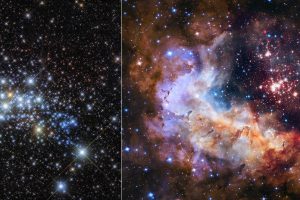Two cycles, two programs. The astronomers of the INAF – OAPA will study the star formation in extreme environments wth JWST

The formation of stars and planets results from the complex interplay of various factors and agents: the collapse of the cloud due to its own gravitational force, its internal turbulence and magnetic effects, the evolution of star clusters formed within, and the interactions among young stars within these clusters, as well as the influence of their radiation on the surrounding cloud and neighboring stars. Several star-forming regions exist within a few thousand light-years from the Sun. These regions have provided us with extensive insight into the star formation process. Nonetheless, these nearby star-forming regions have a significant limitation: they are all low-mass regions (for instance, with a total mass smaller than 10000 solar masses).
This represents a significant limitation. In fact, the usual star-forming regions in galaxies undergoing intense periods of star formation are highly massive regions. These regions form super-massive star clusters (with total masses exceeding 10000 solar masses), typically observed in “starburst” galaxies known for their vigorous star formation. Such galaxies are typically found among the interacting galaxies or in the distant Universe. The Milky Way itself has undergone starburst phases, during which the majority of the stars that populate our Galaxy today were formed.
Within these super-star clusters, the process of star and planet formation occurs in an environment vastly different from that of low-mass regions. These clusters, for example, host rich and compact populations of massive stars (e.g., stars more massive than 10 solar masses) which, due to their intense UV emissions and the collision of their strong and dense winds, generate a localized environment characterized by energetic radiation and high-energy particles. This environment influences multiple processes tied to the formation of stars and planets. For instance, it’s possible that the rapid dispersion of protoplanetary disks, which are gas and dust disks orbiting young stars and sites of planet formation, might impede planet formation in this context. Additionally, it’s plausible that the formation of very low-mass stars is more efficient in such extreme surroundings.
To study of the impact of these environments on star and planet formation, astronomers of the INAF – Astronomical Observatory of Palermo are leading two projects, with the astronomer M. G. Guarcello as the principal investigator, which have been included in the initial two observation cycles of the James Webb Space Telescope. The first project (GO-1905), included in the first observation cycle, entails 19.8 hours of observations of the super-cluster Westerlund 1, likely the most massive star cluster known within the Milky Way. These observations are part of the international project EWOCS (Extended Westerlund One Chandra Survey), which is also based on a long X-ray observation (278 hours) conducted with NASA’s Chandra satellite, along with archival data. The second project (GO-3523), recently added to the second cycle, involves 20.4 hours of observations of the super-cluster Westerlund 2. Given that these two super-clusters exhibit distinct ages, content of massive stars, and nebulosity, comparing the outcomes of these two projects will provide astronomers insights into how and within what timescale such extreme environments influence the formation of stars and planets, as well as the initial evolution of both low-mass and high-mass stars.
The figure (click here to visualize the image interely) shows two wonderful images of Westerlund 1 (left panel) and Westerlund 2 (right panel) with the Hubble Space Telescope.
Mario Giuseppe Guarcello ( follow mariospiegacose) ( mariospiegacose) ( follow mariospiegacose)
Follow the Astronomical Observatory of Palermo on Facebok and on Instagram
Subscribe the Youtube channel of the Astronomical Observatory of Palermo
